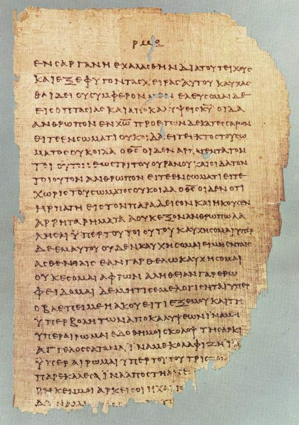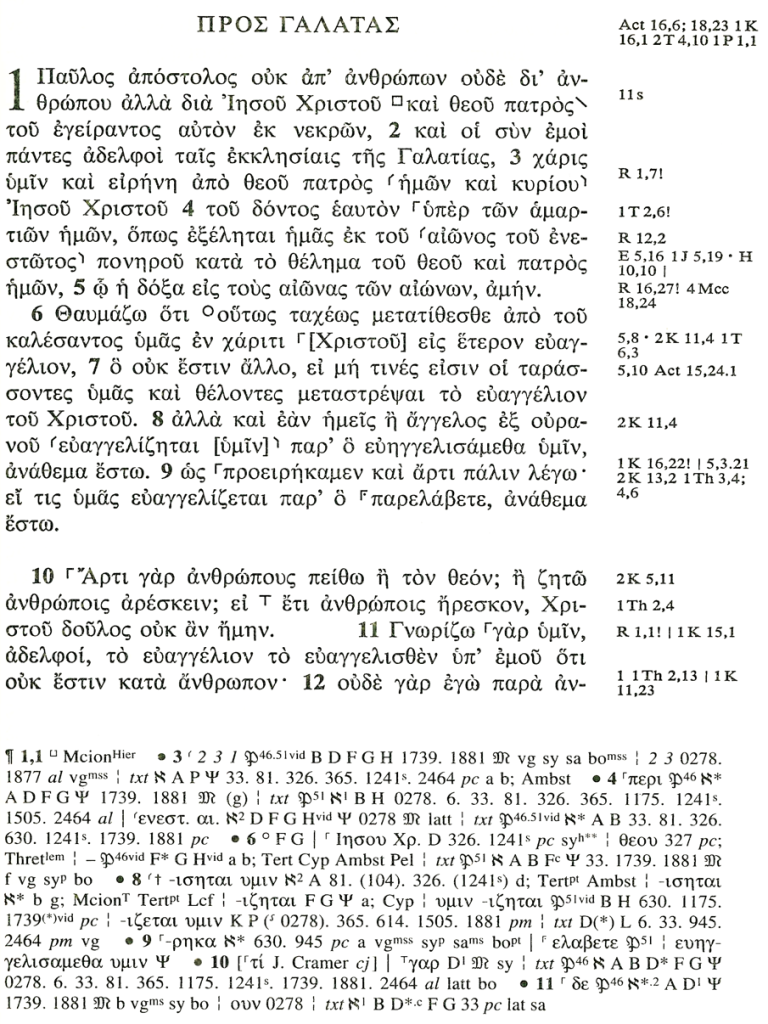16
Textual criticism is the academic discipline that examines and compares biblical manuscripts. One concern of textual criticism is the “recovery” of the original reading of a biblical text. In the course of copying the biblical texts, words are inevitably added, omitted, or changed for unintentional reasons, and sometimes on purpose (scribal emendations). Textual critics are not just concerned with getting back to an original text, but are also often interested in understanding how textual variants are informative for the study of a text in general. In the case of Galatians, there may be dozens of textual variants—that is, areas in the text where manuscripts differ on a word or phrase. Oftentimes the variation is insignificant, as with a difference of spelling (the equivalent of “advisor” vs. “adviser”). There are also occasions, however, where the variation is more weighty.
The art and science of textual criticism can be complex, but in a discussion such as we will have here, it benefits the uninitiated to understand that textual critics consider two kinds of evidence in the study of variants in pursuit of an original reading.
External Evidence. One type of evidence involves consideration of the reliability of the manuscript(s) in question. Any given manuscript, no matter where and when, can be liable to a mistake here and there (as this is only human). However, all things being equal, there is a general presumption that earlier manuscripts are more likely to pass on the original reading compared to later manuscripts because of the simple fact that, over time, there is opportunity for more and more transcription errors to creep in.

This papyrus dates to the late second century or early third century, and what remains is from the Pauline corpus. Regarding Galatians, P46 contains the following intact portions: 1:1–8, 10–24; 2:1–9, 12–21; 3:2–29; 4:2–18, 20–31; 5:1–17, 20–26; 6:1–8, 10–18.We have over one hundred ancient papyri that contain biblical texts, many of which can be dated to the third century CE (NB: we do not have much that comes from the second century). Text Types:
“As individual NT books were received and circulated in the early Christian church, various copies were made and deployed throughout the ancient world. As manuscripts were circulated within particular geographic regions they began to take on particular characteristics/readings, unique to their location, resulting in localized text-types or textual families. Four major textual families have been identified and studied by NT textual critics: (1) Alexandrian, (2) Western, (3) Caesarean, and (4) Byzantine.”[1]
A large group of relatively early manuscripts is called majuscules. These are written in uppercase letters, with no spaces between words and no punctuation. A small number of these can be dated to the fourth century CE. Many more are from the fifth to tenth centuries. We have a plethora of manuscripts that are in the minuscule (lowercase) script; these date largely from about the ninth to the fifteenth centuries and beyond.
When factoring in external evidence, text critics consider the strongest readings to be those for which manuscript support is early and for which such support comes from a wide geographic distribution. Sometimes consideration is given to which “text type” the reading comes from; manuscripts associated with the so-called Alexandrian text type are considered by many scholars to be more reliable than manuscripts from other text types.
Internal Evidence. Another consideration in weighing variants involves how the text reads in and of itself (without looking at the age or origins of the manuscript[s]). The goal of internal analysis is to explain what may have given rise to a particular variant, then to work backwards to an original reading. There are a few factors that guide these considerations. For example, some scribal changes that are unintentional include dittography (i.e., a scribe may have accidentally written the same letter twice, thus possibly changing the next word). We get a strong sense that some scribes changed their texts on purpose, presumably with the noble intention of clarification or perhaps to correct what they thought were mistakes in the texts in front of them. Two important principles that relate to intentional scribal editing include lectio brevior and lectio difficilior. Lectio brevior means “shorter reading”—that is, all things being equal, the shorter reading is most likely to be original because a scribe is more likely to add to a biblical text than to remove wording. Lectio difficilior means “more difficult reading.” That is, all things being equal, a scribe is more likely to simplify what he thought was a convoluted text than to make it more confusing. Thus, if confronted with a variant that is more convoluted, seemingly less orthodox, or in any way “troubling,” compared to a variant that reads more comfortably, the chances are that the original reading is the more “difficult” one—simply because the easier reading fits the concerns and motives of a scribe. No sensible scribe would willingly complicate a biblical text.
Reading the Greek Text with a (Textual) Critical Apparatus

The Greek New Testament Nestle-Aland (twenty-eighth edition; hereafter NA28) contains a scholarly reconstruction of the (presumed) original Greek text. This means that teams of scholars sifted through textual variants and analyzed and weighed the evidence that would lead to choosing the strongest readings in any given case. The text presented is the result of their decisions, but at the bottom of the text is the “critical apparatus” (hereafter CA) where the reader can find more information about the debated variants (not all variants, but those that are the strongest contenders for the most likely original readings or variants that are especially controversial). The various codes and symbols in the CA can be confusing and overwhelming, so the NA28 contains a lengthy guide to the CA.
In this lesson, we will look at only a handful of instances of textual variation, though there are hundreds of variants for the Greek text of Galatians and nearly forty occasions where scholars believe it is worthwhile to have a discussion about the best options.
Example 1: “Our Father” or “Our Lord Jesus? (Galatians 1:3)
Let’s start off with a rather simple text-critical problem.
The NA28 reading of this verse is as follows:
χάρις ὑμῖν καὶ εἰρήνη ἀπὸ θεοῦ πατρὸς ἡμῶν καὶ κυρίου Ἰησοῦ Χριστοῦ
According to the CA of the NA28, the above text has the strongest support (based on external and internal considerations). With respect to the portion ἀπὸ θεοῦ πατρὸς ἡμῶν καὶ κυρίου Ἰησοῦ Χριστοῦ, some manuscripts read differently:
Reading 1: ἀπὸ θεοῦ πατρὸς ἡμῶν καὶ κυρίου Ἰησοῦ Χριστοῦ (NA28 preference)
Reading 2: ἀπὸ θεοῦ πατρὸς καὶ ἡμῶν κυρίου Ἰησοῦ Χριστοῦ
Reading 3: ἀπὸ θεοῦ πατρὸς καὶ κυρίου Ἰησοῦ Χριστοῦ
Discussion Question: How do these differ in meaning?
Reading 1: “ . . . from God our Father and the Lord Jesus Christ”
Reading 2: “ . . . from God the Father and our Lord Jesus Christ”
Reading 3: “ . . . from God the Father and the Lord Jesus Christ”
Example 1 Continued
There is not strong external support for the third reading—that is, the manuscripts that attest to that reading are not as early as those that support the first two readings. Regarding readings 1 and 2, the external support for both is quite strong. The UBS[2] committee gave preference to Reading 1 (ἡμῶν καὶ κυρίου) because “it accords with Paul’s usage elsewhere.”[3] Bruce Metzger, chair of the committee, explains that Reading 2 may have arisen out of “Christian piety,” as a scribe may have chosen to place ἡμῶν with Jesus Christ rather than God the Father. Ultimately, Metzger’s committee only gave preference for Reading 1 a “B” grade in terms of the level of confidence that this reading is superior to other viable readings.
Example 2: “Because of Transgressions”? (3:19)
Another interesting case study in the textual transmission of Galatians involves the much discussed statement made by Paul in chapter three. After explaining the temporary and limited role of Torah, he writes this:
Τί οὖν ὁ νόμος; τῶν παραβάσεων χάριν προσετέθη (UBS preference)
The UBS committee has put much confidence in this reading (especially regarding its external support), but they note some unusual variants that have appeared, even in otherwise reliable manuscripts. Here are two such variant readings:
Τί οὖν ὁ νόμος; τῶν παραδοσεων χάριν προσετέθη (D*)
Here it would be translated, “Why then the Law? It was added on account of traditions.” It is unclear exactly what this would mean, but Paul does use παράδοσις in Gal 1:14.
Perhaps more convoluted is this variant reading:
Τί οὖν ὁ νόμος [;] τῶν πραξεων [omitting χάριν προσετέθη]
This would produce the translation “Why then the law of actions?” This variant reading was rejected by the UBS committee but happens to come from a manuscript (P46) that is traditionally very reliable.
- S. E. Porter and A. W. Pitts, Fundamentals of New Testament Textual Criticism (Grand Rapids: Eerdmans, 2016), 78. ↵
- A special committee of the United Bible Society is responsible for the text-critical decisions in the NA text. ↵
- B. M. Metzger, A Textual Commentary on the Greek New Testament, 2nd ed. (London: United Bible Socities, 1994), 520. ↵
